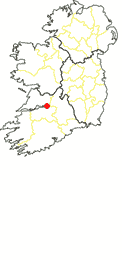
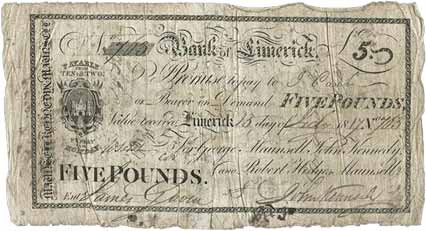
Thomas Maunsell originally founded the Bank of Limerick in 1789 with partners Robert Maunsell, Sir Matthew Blakiston, Thomas Brooke and Richard Maunsell. The bank was founded on 2 July 1789. It is believed to be the first bank founded in Limerick. The bank went through a number of partnership changes ultimately becoming George Maunsell & Co.
The bank was well run, with a modest note issue. It was held in high esteem by the people of Limerick and its environs. Some of the smaller note issuers in the region, such as the 'Ennis Banks', made their notes payable in "Limerick Bank Paper", a demonstration of the confidence that Maunsell's held.
The Maunsell family [2] originated in Buckinghamshire and came to Ireland in the early 16th century, to settle in Mocollop, Co. Waterford. The family received lands in Limerick and Galway in the 17th century.
Richard Maunsell (d. 1773) inherited the Maunsell family estates and settled in Limerick in the 18th century and was Mayor of Limerick in 1734. He went on to be MP for Limerick City in the Irish Parliament from 1740 to 1761, during which time the city developed as a centre of Atlantic trade.
Available data suggests that this Richard Maunsell was the grandfather of Thomas and Robert Maunsell who founded the Bank of Limerick (their father was also named Thomas). The Richard Maunsell listed in the first partnership (1789-1794) is likely to have been their brother, the eldest of the brothers, who is recorded as having emigrated to America after graduating from Trinity College, Dublin. He died in America.
Robert Maunsell had made his fortune in India. On his return to Ireland in 1789 he was a co-founder of Maunsell’s Bank with his brother Thomas and Sir Matthew Blakiston.
Following the closure of several banks in Cork in the 1820 crisis, most notably Roberts and Leslie, leaving only the long-established Pike's Bank still open, Maunsell’s Bank came under heavy pressure with a continuous run on it over several days. This resulted in the failure of the bank when it had to stop payment on its notes. The bank closed on Saturday 27 May 1820.
The closure of Maunsell’s Bank in turn put pressure on other banks in the area. It lead to a run on Bruce's Bank in Limerick which closed on the following Monday, 29th May, with Bruce's Charleville Bank in Co. Cork also closing on that day.
It could be argued, that with some assistance, Maunsell’s bank might have been saved, as it had a low deficit of liabilities over assets at £2,446 [4. Kenny & Turner, 2019, Table 4, p. 532], much less than that of many other banks. However, as a bank, it was probably operating on too low a margin and would unlikely have been in a position to provide sufficient security to Bank of Ireland for an advance of funds to keep its doors open.
After the collapse of the bank in 1820 Thomas Maunsell went on to become MP for Johnstown. Robert Maunsell later returned to India and settled there, where he was elected to the Supreme Council of Madras.
There are two general design types of banknotes recorded for the Bank of Limerick, and eight possible Types by partnership. Other series of banknotes are likely. The final series, Series H, was printed on both sides with a common reverse for all denominations. It is unknown if other series were also printed on the reverse. Examples of the notes of the final series are quite common in both issued and unissued form. Notes of earlier partnerships are very rare, and only the illustrated example from the first partnership is available.
Series Type A. ca1789-1794. One single banknote has been recorded, a 20 Guinea note which was in a dnw (Noonan's) sale in 2010, illustrated below.
This note is a mystery, in that it appears to be dated 19th May 1829, a Tuesday, nine years after the bank failed, and 35 years after Richard Maunsell left the partnership. As such, that date cannot be valid. It is highly unlikely that a note would be issued with a partner's name on it, after that person had left the partnership.
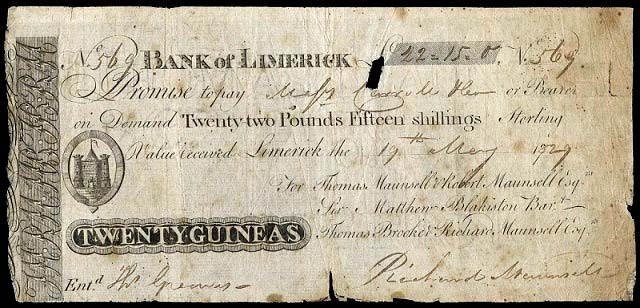
[6. ex Noonan's (DNW), 30 Sept 2010, Lot 2854]
Originally printed for dating in the 1700s with a leading 17, the 7 is overwritten by hand on this note. This note is signed by Richard Maunsell, who was in partnership A only, up to 1794. All details on the note appear to be written in the same handwriting and ink.
There are several possible explanations for the note. It is possible that the note in its entirety was filled out much later by someone other than Richard Maunsell, who is recorded as having emigrated to America where he died. Also possible is that Richard Maunsell post-dated the note.
An image of the reverse of this note may help to solve the mystery as endorsements could provide additional insights regarding the history of the note.
No notes have been seen of partnerships B through G.
Series Type H. 1815-1820. Four design varieties. It appears that banknotes were numbered up to or below 1000 notes per date, as no notes have been seen numbered above three digits. Two variations of the reverse: shaded on Design 1 and 2; outline on Design 3 and 4.
Design 1. Maunsell's Bank of Limerick 1815-1817
Opening Hours stated on the left of each banknote. 'Promise to pay the Bearer on Demand in Bank of Ireland Paper' stated on each note. Denominations seen: £1, 25 Shillings, 30 Shillings, 1G, 1.5G.
Design 2. Maunsell's Bank of Limerick 1816-1817
Opening Hours stated on each banknote. 'Promise to pay to J. Cash or Bearer on Demand' stated on each note. Denominations seen: £5, 4G.
Design 3. Maunsell's Bank of Limerick 1815-1819
Opening hours discontinued from banknotes. 'Promise to pay to J. Cash or Bearer on Demand' stated on each note. Printers imprint on face of most denominations - 4 varieties depending on denomination. Denominations seen: 25 Shillings, 30 Shillings, 3G.
Design 4. Maunsell's Bank of Limerick 1819-1820
New engraving of title 'Bank of Limerick' without full stop. Alterations in typeface used in body of notes, and minor design modifications. Printers imprint on face of most denominations - 4 varieties depending on denomination. Denominations seen: £1, 30 Shillings, £3, £5, £10, 1G, 1.5G.
Eight Types by partnership. Some of these partnerships may not have issued notes. Besides one anomalous note of Type A, only notes of Type H have been seen.
Type A. 1789-1794. Thomas Maunsell, Robert Maunsell, Sir Blakiston Bart, Thomas Brooke, Richard Maunsell.
Type B. 1794-1799. Thomas Maunsell, Robert Maunsell, Sir Blakiston Bart.
Type C. 1799-1804. Thomas Maunsell, Robert Maunsell.
Type D. 1804-1810. Thomas Maunsell, Robert Maunsell, John Kennedy.
Type E. 1810-1814. Thomas Maunsell, John Kennedy.
Type F. 1814. John Kennedy, Robert Hedges Maunsell, John Carlton, Jnr. - Carlton withdrew on 5 Oct 1814 after 3 months [3. O'Kelly, p. 100].
Type G. 1814. Thomas Maunsell, John Kennedy.
Type H. ca1815-1820. George Maunsell, John Kennedy, Robert Hedges Maunsell. - George Maunsell joined as senior partner.
Type H. Design 1. Reverse design A. Promise to pay Bearer in 'Bank of Ireland Paper'
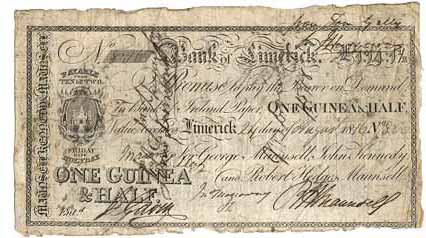

Type H. Design 2. Promise to pay J. Cash or Bearer


Type H. Design 3. Opening hours discontinued. Reverse design B introduced
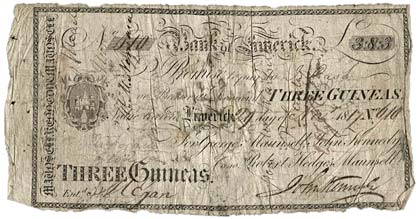
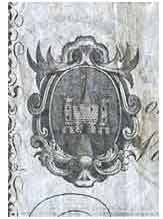
Type H. Design 4. No full stop after 'Bank of Limerick' title. Printer's name added - four varieties
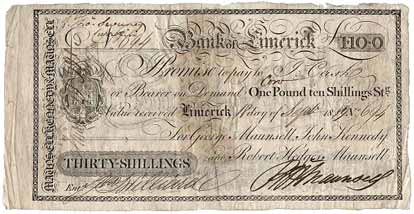
Printer's imprints appear on the face of most denominations of Design 3 and Design 4 notes, as illustrated below.

'Ashby & Ball. London' in curve, under bank symbol on left. 30s, 1.5G
'Ashby London' linear, under bank symbol on left. £3, £10, 1G
'Ashby Co. London' linear, under denomination numeral on top right. £1
'Improved by Ashby, London' in curves, above and below denomination numeral on top right. 25 Shillings
No printer's imprint: £5, 3G.
All notes of Series H have the same printer's imprint centred above the reverse design.

Ashby were London-based printers. They printed notes for several other Irish private banks, including some of the smaller merchant issuers of notes such as Denis Moylan in Cork.
Two designs of reverse were used, with 'Bank of Limerick' in outline on earlier notes of Design 1 and 2; and 'Bank of Limerick' in solid letters on later notes of Design 3 and 4.
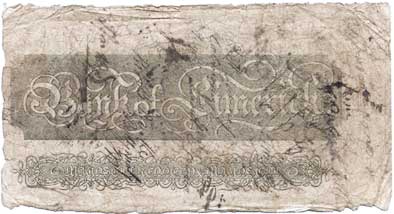
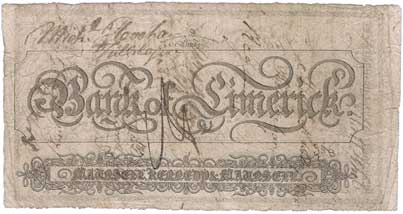
Linked Picture Pages
Design 1. 1815-1817. Denominations seen: £1, 25 Shillings, 30 Shillings, 1G, 1.5G.
Design 2. 1816-1817. Denominations seen: £5, 4G.
Design 3. 1815-1819. Denominations seen: 25 Shillings, 30 Shillings, 3G.
Design 4. 1819-1820. Denominations seen: £1, 30 Shillings, £3, £5, £10, 1G, 1.5G.
References
1. NUIG Landed Estates Database: The origins of the Maunsell family, hosted on the website of the National University of Ireland Galway.
2. Maunsell family website with the greater family history.
Burke's Irish Family Records on the Maunsells, hosted on the Limerick City council website.
3. O’Kelly, E. (1959). The Old Private Banks and Bankers of Munster. Cork: Cork University Press.
4. Kenny, S., Turner, J. D. (2019). 'Wildcat bankers or political failure? The Irish financial pantomime, 1797–1826', European Review of Economic History 24(4).
5. Auction Catalogue, Noonan's (DNW), London. Important Collection of Irish Paper Money formed by Bob Blake (Part I), 2 Oct 2008.
6. Auction Catalogue, Noonan's (DNW), London. Important British and World Paper Money, 30 Sept 2010
7. Auction Catalogue, Noonan's (DNW), London. Important Collection of Irish Paper Money formed by Bob Blake (Part II), 14 March 2009.
8. Auction Catalogue, Noonan's (DNW), London. Coins, Tokens, Historical Medals & Papermoney, 7 Dec 2015.
9. Auction Catalogue, Noonan's (DNW), London. Paper Money, 11 April 2016
10. Auction Catalogue, Noonan's (DNW), London. Important British and World Banknotes, 16 March 2006
11. Auction Catalogue, Noonan's (DNW), London. Important British, Irish and World Banknotes, 20 June 2006
12. Auction Catalogue, Noonan's (DNW), London. British and World Paper Money, 29 Sept 2011.
13. Auction Catalogue, Whytes, Dublin. Coins, Banknotes, Medals & Militaria, 23 February, 2001.